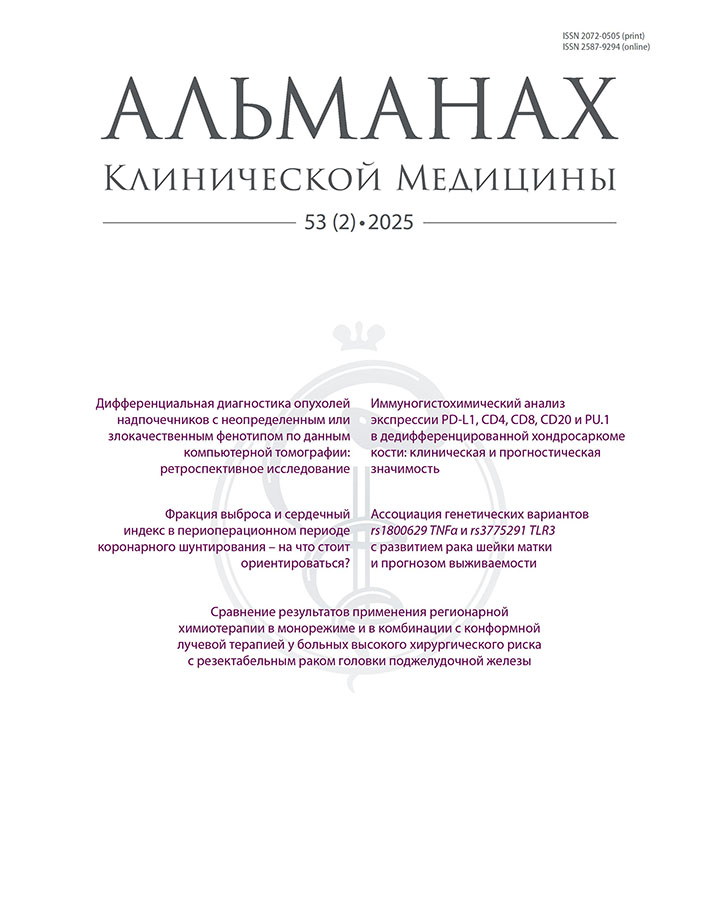ПОСТИНСУЛЬТНЫЕ АРТРОПАТИИ: ФЕНОМЕНОЛОГИЯ, СТРУКТУРНЫЕ ИЗМЕНЕНИЯ СУСТАВОВ
- Авторы: Теленков А.А.1, Кадыков А.С.1, Вуйцик Н.Б.1, Козлова А.В.1, Кротенкова И.А.1
-
Учреждения:
- ФГБНУ «Научный центр неврологии»
- Выпуск: № 39 (2015)
- Страницы: 39-44
- Раздел: ОРИГИНАЛЬНЫЕ СТАТЬИ
- Дата публикации: 15.06.2015
- URL: https://almclinmed.ru/jour/article/view/214
- DOI: https://doi.org/10.18786/2072-0505-2015-39-39-44
- ID: 214
Цитировать
Полный текст
Аннотация
Актуальность. В постинсультный период у больных часто развиваются артропатии суставов паретичных конечностей, что может привести к образованию контрактур, при которых изза резкой болезненности в области суставов значительно ограничивается объем активных и пассивных движений. Это препятствует восстановлению двигательных функций; как следствие, резко снижается качество жизни пациентов.
Цель – изучить феноменологию постинсультного артропатического синдрома и структуру суставных нарушений при нем.
Материал и методы. У 148 больных с постинсультными гемипарезами проанализировали демографические показатели, характер, локализацию и размер инсульта, наличие или отсутствие сопутствующей дисциркуляторной энцефалопатии и сахарного диабета. Оценивали неврологический статус в целом и степень двигательных нарушений. Определяли патогенетический подтип ишемического инсульта (дуплексное сканирование магистральных артерий головы, оценка гемореологических свойств крови, липидный профиль). Исследование суставов проводили с помощью методов ультразвукового исследования и компьютерной томографии.
Результаты. Из 148 обследованных пациентов 118 были с постинсультными гемипарезами без поражения суставов и 30 с постинсультными гемипарезами, сопровождавшимися артропатиями. Преобладали пациенты пожилого возраста (60 лет и старше) – 75 больных (16 из них – с артропатией). У 120 обследованных диагностирован ишемический характер инсульта, у 28 – геморрагический. Среди общего количества больных наибольшую долю имел лакунарный подтип – в 29 (24%) наблюдениях, в группе больных с артропатиями – кардиоэмболический (8, 33%). Из 30 больных с артропатиями изолированная артропатия плечевого сустава наблюдалась у 26 пациентов, в комбинации с артропатиями других суставов – у 2, изолированная артропатия лучезапястного сустава – еще у 2. Артропатии развивались в первые 2–3 недели после инсульта у 9 пациентов (в том числе артропатии плечевых суставов у 7). У остальных пациентов они развивались в течение первых 2 месяцев (но позднее 3-й недели).
Заключение. Постинсультные артропатии встречаются достаточно часто – в 20% случаев среди всех больных с постинсультными гемипарезами – и в основном у лиц пожилого и сред- него возраста. Отмечено преобладание артро-патий у больных с очагами в правом полушарии и с кардиоэмболическим подтипом ишемического инсульта. Значительно чаще артропатии встречаются при грубом и выраженном парезе.
Об авторах
А. А. Теленков
ФГБНУ «Научный центр неврологии»
Автор, ответственный за переписку.
Email: alex-telenko@yandex.ru
врач невролог 3-го неврологического отделения
РоссияА. С. Кадыков
ФГБНУ «Научный центр неврологии»
Email: fake@neicon.ru
д-р мед. наук, профессор, руководитель 3-го неврологического отделения Россия
Н. Б. Вуйцик
ФГБНУ «Научный центр неврологии»
Email: fake@neicon.ru
канд. мед. наук, ст. науч. сотр. лаборатории ультразвуковой диагностики
РоссияА. В. Козлова
ФГБНУ «Научный центр неврологии»
Email: fake@neicon.ru
врач лаборатории ультразвуковой диагностики
РоссияИ. А. Кротенкова
ФГБНУ «Научный центр неврологии»
Email: fake@neicon.ru
врач отделения лучевой диагностики
РоссияСписок литературы
- Суслина ЗА, Пирадов МА, ред. Инсульт: диагностика, лечение, профилактика. М.: МЕДпресс-информ; 2008. 288 с. Suslina ZA, Piradov MA, editors. Insul't: diagnostika, lechenie, profilaktika [Stroke: diagnostics, treatment, prevention]. Moscow: MEDpress- inform; 2008. 288 p. (in Russian).
- Кадыков АС. Трофические изменения суставов парализованных конечностей у больных, перенесших инсульт. Клиническая медицина. 1973;(9):65–8. Kadykov AS. Troficheskie izmeneniya sustavov paralizovannykh konechnostey u bol'nykh, perenesshikh insul't [Trophic abnormalities in joints of paretic limbs in post-stroke patients]. Klinicheskaya meditsina. 1973;(9):65–8 (in Russian).
- Столярова ЛГ, Ткачева ГР. Реабилитация больных с постинсультными двигательными расстройствами. М.: Медгиз; 1978. 216 с. Stolyarova LG, Tkacheva GR. Reabilitatsiya bol'nykh s postinsul'tnymi dvigatel'nymi rasstroystvami [Rehabilitation of patients with post-stroke motor dysfunction]. Moscow: Medgiz; 1978. 216 p. (in Russian).
- Culham EG, Noce RR, Bagg SD. Shoulder complex position and glenohumeral subluxation in hemiplegia. Arch Phys Med Rehabil. 1995;76(9):857–64.
- Chironna RL, Hecht JS. Subscapularis motor point block for the painful hemiplegic shoulder. Arch Phys Med Rehabil. 1990;71(6):428–9.
- Кадыков АС. Реабилитация после инсульта. М.: Миклош; 2003. 176 с. Kadykov AS. Reabilitatsiya posle insul'ta [The post-stroke rehabilitation]. Moscow: Miklosh; 2003. 176 p. (in Russian).
- Столярова ЛГ, Кадыков АС, Ткачева ГС. Система оценок двигательных функций у больных с постинсультным гемипарезом. Журнал невропатологии и психиатрии им. С.С. Корсакова. 1982;82(9):15–8. Stolyarova LG, Kadykov AS, Tkacheva GS. Sistema otsenok dvigatel'nykh funktsiy u bol'nykh s postinsul'tnym gemiparezom [A system for assessment of motor functions in patients with a post-stroke hemiparesis]. Zhurnal nevrologii i psikhiatrii im. S.S. Korsakova. 1982;82(9):15–8 (in Russian).
- Новиков НВ, Яхно НН. Синдром рефлекторной симпатической дистрофии. Журнал неврологии и психиатрии им. С.С. Корсакова. 1994;94(5):103–7. Novikov NV, Yakhno NN. Sindrom reflektornoy simpaticheskoy distrofii [A syndrome of reflectory sympatic dystrophy]. Zhurnal nevrologii i psikhiatrii im. S.S. Korsakova. 1994;94(5):103– 7 (in Russian).
- Никифоров АС, Мендель ОИ. Болевой синдром в плечелопаточной области: современные подходы к диагностике и лечению. Русский медицинский журнал. 2008;16(12):1700–5. Nikiforov AS, Mendel' OI. Bolevoy sindrom v plechelopatochnoy oblasti: sovremennye podkhody k diagnostike i lecheniyu [Humeroscapular pain syndrome: modern approaches to diagnosis and treatment]. Russian Medical Journal. 2008;16(12):1700–5 (in Russian). 10. Широков ВА. Боль в плече. Патогенез. Диагностика. Лечение. М.: МЕДпресс-информ; 2012. 240 c. Shirokov VA. Bol' v pleche. Patogenez. Diagnostika. Lechenie [Painful shoulder. Pathophysiology. Diagnostics. Treatment]. Moscow: MEDpressinform; 2012. 240 p. (in Russian).
- Яхно НН, ред. Болевой синдром: патофизиология, клиника, лечение. М.: ИМА-пресс; 2011. 72 с. Yakhno NN, editor. Bolevoy sindrom: patofiziologiya, klinika, lechenie [Pain syndrome: pathophysiology, clinical manifestation and treatment]. Moscow: IMA-press; 2011. 72 p. (in Russian).
- Вейн АМ, Авруцкий МЯ. Боль и обезболивание. М.: Медицина; 1997. 280 с. Veyn AM, Avrutskiy MYa. Bol' i obezbolivanie
- [Pain and analgesia]. Moscow: Meditsina; 1997. 280 p. (in Russian).
- Меньшикова ИВ, Сергиенко СА, Пак ЮВ, Морозов СП, Виноградова ЕВ. Боль в области коленного и плечевого суставов (алгоритмы дифференциальной диагностики). М.: Медпрактика; 2007. 140 с. Men'shikova IV, Sergienko SA, Pak YuV, Morozov SP, Vinogradova EV. Bol' v oblasti kolennogo i plechevogo sustavov (algoritmy differentsial'noy diagnostiki) [Knee and shoulder joint pain (algorithms of differential diagnosis)]. Moscow: Medpraktika; 2007. 140 p. (in Russian).
- Сашина МБ, Кадыков АС, Черникова ЛА. Постинсультные болевые синдромы. Атмосфера. Нервные болезни. 2004;(3):25–7. Sashina MB, Kadykov AS, Chernikova LA. Postinsul'tnye bolevye sindromy [Post-stroke pain syndromes]. Atmosphere. Nerve Diseases. 2004;(3):25–7 (in Russian).
Дополнительные файлы








